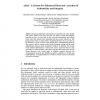Free Online Productivity Tools
i2Speak
i2Symbol
i2OCR
iTex2Img
iWeb2Print
iWeb2Shot
i2Type
iPdf2Split
iPdf2Merge
i2Bopomofo
i2Arabic
i2Style
i2Image
i2PDF
iLatex2Rtf
Sci2ools
PERVASIVE
2004
Springer
2004
Springer
eSeal - A System for Enhanced Electronic Assertion of Authenticity and Integrity
Ensuring authenticity and integrity are important tasks when dealing with goods. While in the past seal wax was used to ensure the integrity, electronic devices are now able to take over this functionality and provide better, more fine grained, more automated and more secure supervision. This paper presents eSeal, a system with a computational device at its core that can be attached to a good, services in the network and a communication protocol. The system is able to control various kinds of integrity settings and to notify authenticated instances about consequent violations of integrity. The system works without infrastructure so that goods can be supervised that are only accessible in certain locations. The paper motivates the eSeal system and its design decisions, lists several types of integrity scenarios, presents the communication protocol and identifies practical conditions for design and implementation. An implementation in a business relevant scenario is presented as a proof ...
| Added | 02 Jul 2010 |
| Updated | 02 Jul 2010 |
| Type | Conference |
| Year | 2004 |
| Where | PERVASIVE |
| Authors | Christian Decker, Michael Beigl, Albert Krohn, Philip Robinson, Uwe Kubach |
Comments (0)

